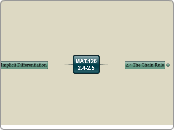MAT.126
2.4-2.5
2.4 The Chain Rule
Find the derivative of a composite function using the Chain Rule
Decomposition
Find the derivative of a function using the General Power Rule
Radicals
Quotients with Constant Numerators
Simplify the derivative of a function using algebra
Factoring Out Least Powers
Quotients
Powers
Find the derivative of a trigonometric function using the Chain Rule
Parentheses
Repeated Application of the Chain Rule
Tangent Lines
Summary of Differentiation Rules
2.5 Implicit Differentiation
Distinguish between functions written in implicit form and explicit form
Use implicit differentiation to find the derivative of a function
Chain Rule
Process
Graphing Implicit Relations
Slope of an Implicit Graph
Explicit Domains for Implicit Functions
Higher-Order Implicit Derivatives
Tangent Line to an Implicit Graph
